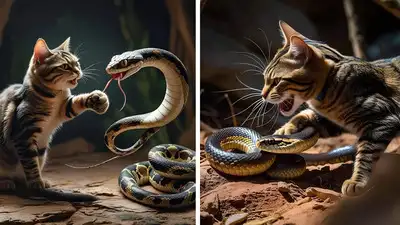ARTICLE AD BOX

From rural backyards to the lanes of Indian towns, videos of cats taking on snakes are going viral. The clips are short but gripping, and they often leave viewers wondering: how does an ordinary house cat manage to challenge a snake and sometimes even come out on top?Snakes are often seen as dangerous, silent, quick, and sometimes venomous.
Cats, on the other hand, are viewed as calm, curious, and playful. But when the two cross paths, especially in unexpected outdoor encounters, the outcome can be surprising. In many of these cases, the cat appears to take control of the situation.This trend isn’t just about viral videos. It offers a real glimpse into nature– two predators with very different instincts and survival tactics. And when we look at how each animal is built and behaves, the results start to make more sense.Natural hunters at heartDomestic cats might live indoors and relax on soft cushions, but their natural instincts are still there. They’re made to chase, stalk, and pounce. Even well-fed pet cats often hunt small animals like lizards, birds, and sometimes snakes.When a cat sees a snake, it usually doesn’t get scared. Instead, it stays calm, watches carefully, and only attacks if it feels threatened. Cats rely on their instincts and quick reflexes, which help them stay confident in these situations.
Speed and reaction time give cats an edgeCats have a big edge over snakes because they react much faster. Reports suggest that cats can react up to seven times quicker than snakes. This helps them quickly dodge snake bites and strike back fast. Cats start building their reflexes and coordination just weeks after they’re born. These skills get better as they grow, helping them stay safe and fight back when needed.Agility vs. direct strikesSnakes strike fast in a straight line, but their movement is limited during an attack.
They mostly rely on surprise and one quick hit. Cats, on the other hand, have flexible bodies and great coordination. They can jump sideways, move back, or pounce from different directions– all in a flash.
According to A-Z-Animals(dot)com, cats’ unpredictable moves make it hard for snakes to catch them. Because cats can quickly change position, they often stay one step ahead in these sudden face-offs.The senses that keep cats alertCats have sharp senses.
They see well in the dark and can hear very quiet sounds that humans can’t. Their whiskers also help them feel movements and vibrations around them.Snakes have some special abilities too, like sensing heat and feeling vibrations through the ground. But their eyesight isn’t great, and they can’t hear well. This often puts them at a disadvantage when facing a quick and alert cat up close.When claws meet fangsA snake’s biggest advantage is its bite, especially if it’s venomous.
But the snake has to land the bite first. If a cat is quick enough to dodge, the snake becomes vulnerable. Cats use their claws and teeth to strike fast and often, aiming for the snake’s head or neck.According to reports, many snakes have fragile bones in their upper body. Repeated strikes from a cat’s claws can seriously hurt the snake before it can react again.Every encounter is differentIt’s important to remember that not all cats win, and not all snakes lose.
Big, venomous snakes like cobras or vipers can be immensely dangerous. Many cats naturally stay away or run if they sense real danger.Who wins depends on many things– the type of snake and cat, where they meet, their size, and how experienced the cat is. Outcomes aren’t always predictable, and in areas with venomous snakes, even a small bite can be deadly for a cat.A fight of instincts, not just strengthWhen a cat meets a snake, it’s not about size but about instincts and quick reactions. Cats often win because they are fast, alert, and use their sharp senses well, especially against smaller or non-venomous snakes.However, these fights can be risky, and cats don’t always come out safe. Still, their speed and awareness usually give them an advantage in many encounters.
Note: This information is based on various online sources.



.png)
.png)
.png)
















 1 day ago
4
1 day ago
4









 English (US) ·
English (US) ·